The latest Harpoon PBEM game used a scenario from the Harpoon Naval
Review 2009, written by Gorka L. Martínez Mezo: Moroccan
fundamentalists attack the Spanish outposts at Ceuta and Melilla, and
the Spanish try to get convoys across the western Mediterranean to
evacuate civilians and bring in troops.
There's significant neutral fishing and merchant traffic present
(I wrote a generator to give them plausible movements through the
day), and given the huge force disparity it's suggested that the
Moroccan forces hide among them. The Spanish forces could set up
anywhere in the blue circles (with the convoys at Málaga and Melilla,
or near the radar station at Isla de Alborán); the Moroccans could set
up anywhere outside the red ones.
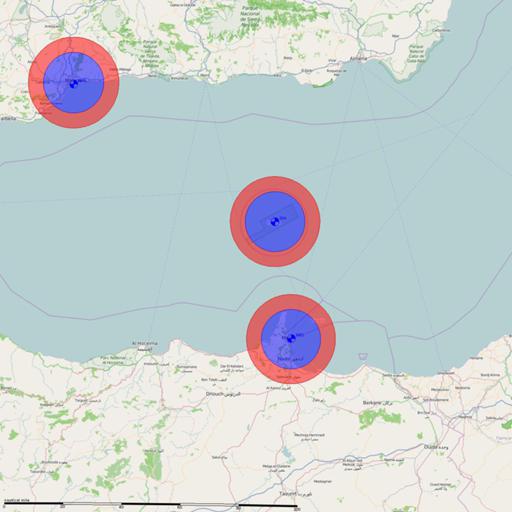
The Spaniards split their naval forces between the two convoys,
putting none near the island. The Moroccans put some warships in with
the northern freighter traffic, some near Melilla, and their martyrdom
boats mixed with the fishing fleet. They immediately picked up
airborne radar from the Spanish P3-M Orion to the north.
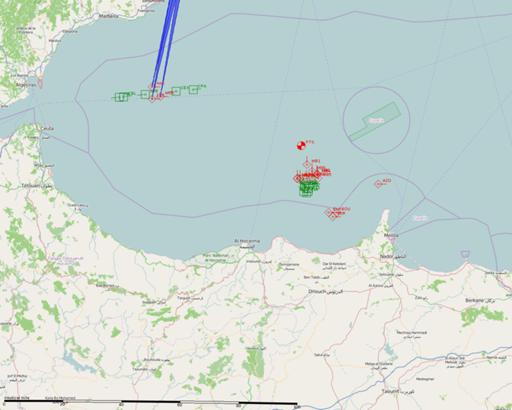
Spanish fighters patrolled over the convoys. One of them spotted the
southern Moroccan warships, and helicopters were launched from the
southern escort force.
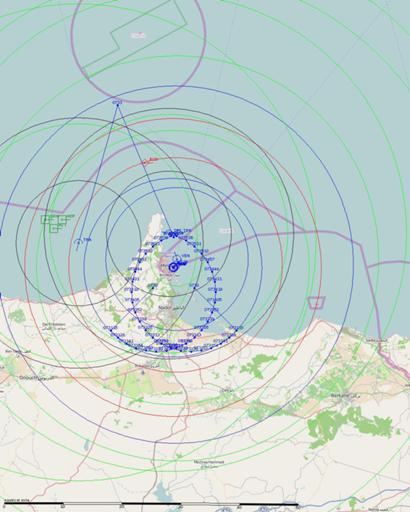
They engaged and sank the Moroccans with Penguin missiles; they were
able to get close enough for visual identification without being
spotted themselves, and the Moroccans weren't using air search radar
so as to be mistaken for civilian ships.
The northern force put up a Panther helicopter, which was spotted
comprehensively when it turned on its radar.
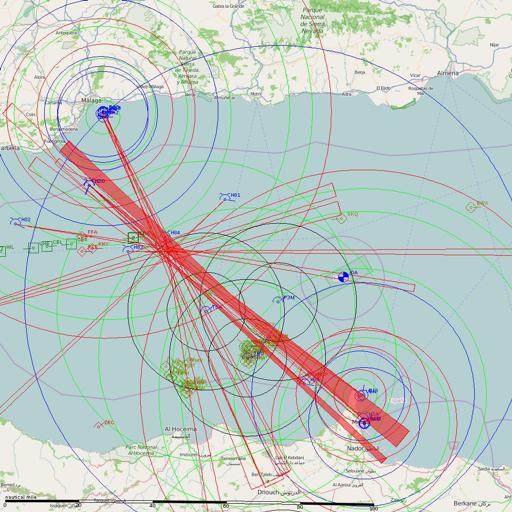
Helicopters from the northern convoy similarly inspected the
"merchant" ships, then called target locations to a Harpoon-equipped
F/A-18 nearby, which was able to sink them with a single salvo.
That left the Moroccans with their Mirage force, inbound for some
time, and the martyrdom boats.
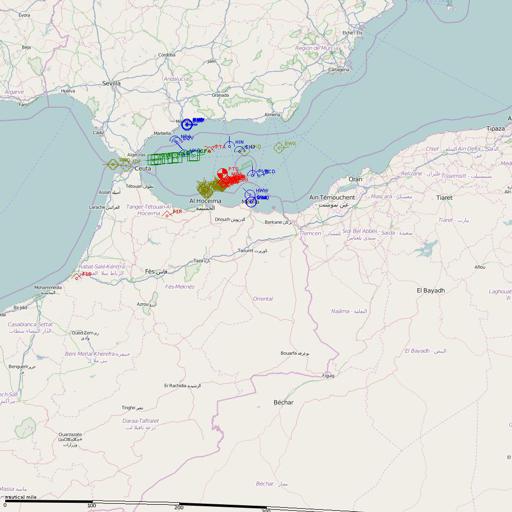
The Mirages were thoroughly radar-painted, but having only RWRs
themselves couldn't locate the enemy aircraft except visually.
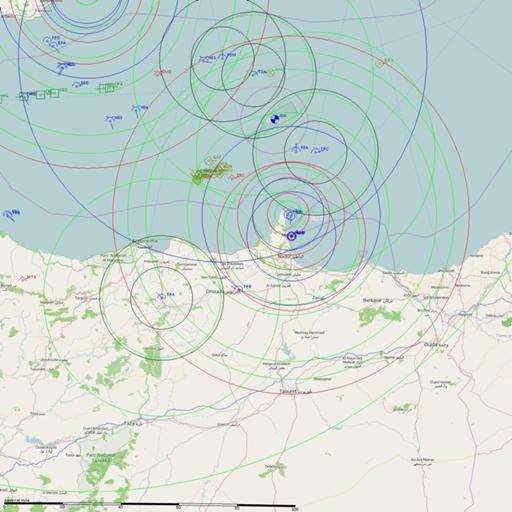
They were knocked out of the sky by AMRAAM fire, at which point the
Moroccans quite reasonably conceded.
Thanks to Rory and Renny for playing. Full charts as presented to the
players are here.
Things I've learned from this game:
-
Well, that wasn't a lot of fun for team red. The idea of hiding
among merchant traffic seemed like a good one, but when the
helicopters could spot the ships at a minimum of 7 miles, and the
ships could only spot the helos at around 3, the Spanish could
identify the enemy and pin down their locations without exposing
themselves, so the first warning the Moroccans had was sighting of
incoming missiles. The only thing they could have done about this
beforehand was to light up their air-search radars, which would have
identified them as hostiles anyway; and even once they'd done that,
their best anti-air weaponry could only reach out to 8.5 miles,
rather less than enemy missile range. So while they might have shot
down more of the incoming missiles, they couldn't have stopped the
helicopters.
-
The visual sighting rules don't say anything about identification. I
think I need to modify the target classification rules that are
already used for sonar so that they can be used with other sighting
methods: a gradual increase in confidence from "a small ship" to "a
Moroccan warship" to "a Descubierta-class corvette" seems more
interesting than simply spotting or not spotting. (The rules also
say nothing about altitude: should you really be able to classify a
target you've spotted from 40,000 feet up? I assumed not.)
-
The scenario seems pretty unbalanced, even omitting the fixed-wing
aircraft which are an optional complication. Yes, obviously the
Moroccan force is inferior, but when both sides are free to fire
on identified targets they're not even going to get to shoot back.
The northern convoy barely got out of harbour, and the southern
wasn't even ready to leave: all the fighting had already happened by
the time it might have been in danger. If the goal of the scenario
was hide-and-seek across the western Med, it failed. If I do
something like this again, I think I might give the Spanish more
restrictive rules of engagement, and definitely omit the fixed-wing
aircraft.
-
The only way I can see for the Moroccans to do well in this game is
to hug the coast to hide from enemy surface radar, and sprint for
the targets right from the start. They probably can't get a good
shot with radar-homing missiles (as the convoys are also close to
the coast), but they may be able to get into effective gun range
before the helos find and kill them.
-
Big complex games like this are hard for the GM to keep track of,
never mind the players. Even with auto-generated map excerpts
centred on each group of units, it was hard to work out what was
going on at times. And working out radar detection, bearing in mind
air units' radar arcs and coastal terrain masking, was more work
than I want to do again in a hurry. I'll probably go for games with
a smaller unit count for a while, or at least fewer civilians
getting in the way; the tables of unit ranges and bearings became
hard to manage with an extra 48 entries that were rarely used.
-
More players always welcome!
- Posted by Owen Smith at
11:21am on
10 August 2015
I always think of these Spanish outposts whenever Spain gets shirty about Gibraltar. Talk about double standards.
- Posted by Rory at
12:03pm on
10 August 2015
As Blue I had such superior equipment that I could have made many blunders and felt little or no pain as a result. The forces available to blue were adequate for a substantial engagement with elements of the Roal Navy or the French or the Italians. Soon into the scenario I felt for the impossible situation of the Red commander not to mention the poor, hopelessly brave Moroccan sailors.
I remember one Lazaga took as many as four Penguin hits and another took four Harpoon hits! Those are 300 ton vessels, the carnage must have been horrific. I leaned from subsequent Harpoon strikes that had I been more careful in using way-points and seeker activations, I could have avoided wasting Harpoons and probably killed far less Moroccan sailors. Honestly I wanted to convince te Moroccan ships to surrender and failing that coordinate search and rescue for the survivors.
This scenario reflects how much air combat has evolved since Vietnam for example, where older generation Soviet planes were still capable of shooting down the most modern American Jets, including with cannon.
I learned a lot nonetheless, but a very sandbox way of learning one might say.
I think an updated scenario could see a concentrated attack on isolated Spanish forces by the Moroccan FREMM and SIGMAS plus older units. They also have AIM-120C, HARM, & Maverick equipped F-16Ds.
Honestly though I find the thought of a Showdown with elements of the Royal Navy over Gibraltar more intriguing.
Thanks Roger and Renny!
- Posted by Rory at
12:13pm on
10 August 2015
Oh, and I strongly agree the visual spotting needs much more detail to be accurately regarded as plausible.
- Posted by Ron A at
03:31pm on
10 August 2015
Um, how about starting every AAR with a list of forces? I'm still not sure what each side actually had.
Other than that, nice write-up. I am in awe of the way you run these games. When I got to play I ranked it far far above paper and pencil and/or playing computer Harpoon.
- Posted by RogerBW at
03:41pm on
10 August 2015
Good thought. The Spanish have a pair of Galicia LPDs in the northern convoy (with helicopters), and two each of Alvaro de Bazan FFGs, Santa Maria FFGs, and Descubierta OPVs. Air forces (apart from the on-board HS.18 and HS.23 helos) were a P-3M, six Eurofighters, and eight F-18Ms.
The Moroccans get a Descubierta FFG, two Floreal FFGs each with a Panther helo aboard, four Lazaga patrol boats, and the ten martyrdom boats which didn't really figure in this at all. Air forces were twelve Mirage F.1EHs.
- Posted by Ryan at
03:48pm on
10 August 2015
An interesting read. Even though it looks like it ended up being a lot of work for limited return, it was still an impressive undertaking.
- Posted by JakeC at
07:02am on
13 August 2015
There are rules in H4 regarding identification of visual targets. See Rule 4.5.8 "Identifying Visual Contacts".
Essentially you need to get within half the maximum visual sighting range to identify exact class in daytime or 75% of range to pick warships from merchants. And a spotting aircraft must be at Low alt band to identify a surface vessel.
This seems a very unbalanced scenario - a Spanish author by any chance? ;-)
- Posted by RogerBW at
09:28am on
13 August 2015
Thanks, yeah - I don't know how many times I've been through the rules and yet failed to spot (har) that…
- Posted by Gorka Luis Martinez Mezo at
03:10pm on
17 August 2015
Thanks for writing! I've read the AAR and found it very detailed and
interesting.
As you mention, the scenario is very umbalanced without correcting factors.
For example, no allowing the use of long range ASMs as Harpoon and Penguin.
That's why there's so many fishing vessels, to ensure nobody used
relatively indiscriminate long range missiles. In real world, these weapons
can't be used in such scenario as, without man in the loop, they would lock
into neutral and friendly targets alike. Adding more "neutral" shipping
would made things more complicated.
Also, an obligatory "visual ID before engaging" rule can be added. Of
course, this would mean going down, not visual ID from 40.000ft which,
technically possible, isn't ideal.
Of course, the real military vessels would have a hard time surviving, but
only a couple hits would get the Red points up.
Comments on this post are now closed. If you have particular grounds for adding a late comment, comment on a more recent post quoting the URL of this one.